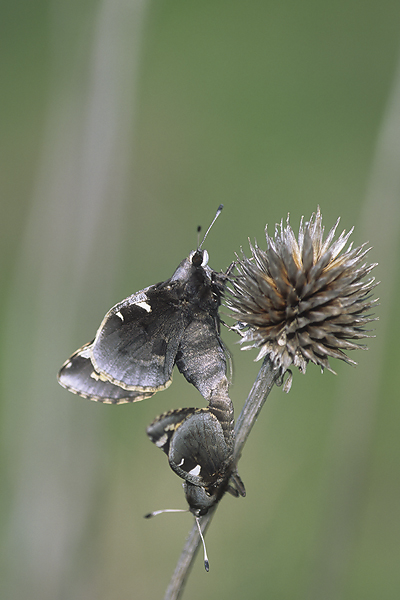The Butterflies of the World Foundation
A Non-




Yucca Giant-
Megathymus yuccae, (Boisduval & Le Conte, [1837])
Subfamily Hesperiinae
Tribe Megathymini

All photographs, artwork, text and website design are the property of The Butterflies of the World Foundation (unless otherwise stated) and are protected under national and international copyright laws. Photographs, artwork or text on this website may not be reproduced in any way without prior written consent of The Butterflies of the World Foundation.
Taxonomy
The family Hesperiidae includes all butterflies that are collectively called skippers because of their fast skipping flight. This family is the sole member of the Superfamily Hesperioidea. Whereas, the other five families of butterflies belong to the Superfamily Papilionoidea. So, skippers are considered butterflies, but they have a few traits different than the species of “True” butterflies found in the Superfamily Papilionoidea. Some of these traits include large eyes, short antennae (often with hooked clubs) and stout bodies. Most also have a very rapid flight with a fast, almost blurred, wing beat. There are about 3,500 species of skippers and they’re further divided into seven subfamilies. They occur worldwide with more found in the tropics. Most species are brown or tan, but some tropical members can be quite colorful.
Megathymus yuccae, male, Chickasaw National Recreation Area, Murray County, Oklahoma,
31 March 2012 Ref #: I-

Megathymus yuccae, male, Chickasaw National Recreation Area, Murray County, Oklahoma,
31 March 2012 Ref #:
I-
General Information:
Megathymus yuccae belongs to the subfamily Hesperiinae. This species is found throughout much of the southern U.S. and northern Mexico. Its preferred habitat includes coastal dunes, desert canyons, open woodland, grassland and old fields.

Megathymus yuccae, female, Chickasaw National Recreation Area, Murray County, Oklahoma,
31 March 2012 Ref #:
I-
Lifecycle:
The larval food source includes various yuccas such as bear grass, Yucca filamentosa,
Smalls yucca, Y. smalliana, Spanish dagger, Y. gloriosa, Y. elata, and Y. arizonica
and Spanish bayonet, Y. aloifolia. Males perch near the host plants to await females.
Females deposit eggs singly to leaves of host plants. Young caterpillars feed near
the tips of leaves and may web together small leaves to make a nest. Older caterpillars
bore into the growing point of the plant and feed on the root. They make a silk chimney
which projects from the growing point. Fully-

Megathymus yuccae, male, Chickasaw National Recreation Area, Murray County, Oklahoma,
31 March 2012 Ref #:
I-

Megathymus yuccae, male, Chickasaw National Recreation Area, Murray County, Oklahoma,
31 March 2012 Ref
#: I-

Megathymus yuccae, courting pair, Chickasaw National Recreation Area, Murray County,
Oklahoma, 31 March 2012 Ref
#: I-

Megathymus yuccae, mated pair, Chickasaw National Recreation Area, Murray County,
Oklahoma, 31 March 2012 Ref
#: I-

Megathymus yuccae, mated pair, Chickasaw National Recreation Area, Murray County, Oklahoma, 31 March 2012
Ref #: I-

Megathymus yuccae, ovipositing female, on soapweed yucca, Yucca glauca, Chickasaw National Recreation Area, Murray County, Oklahoma, 31 March 2012
Ref
#: I-

Megathymus yuccae, ovipositing female, on soapweed yucca, Yucca glauca, Chickasaw National Recreation Area, Murray County, Oklahoma, 31 March 2012
Ref
#: I-

Megathymus yuccae, ovipositing female, on soapweed yucca, Yucca glauca, Chickasaw National Recreation Area, Murray County, Oklahoma, 31 March 2012
Ref
#: I-

Megathymus yuccae, freshly deposited eggs, on soapweed yucca, Yucca glauca, Chickasaw National Recreation Area, Murray County, Oklahoma, 31 March 2012
Ref
#: I-

Megathymus yuccae, freshly deposited egg, on soapweed yucca, Yucca glauca, Chickasaw National Recreation Area, Murray County, Oklahoma, 31 March 2012
Ref
#: I-

Soapweed Yucca, Yucca glauca, a common larval food plant, Lexington Wildlife Management
Area, Cleveland County, Oklahoma Ref #: F-